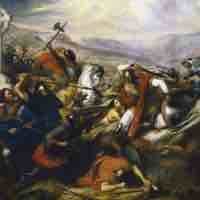Section 3
The Carolingian Dynasty
By Boundless
Charlemagne reached the height of his power in 800 when he was crowned Emperor of the Romans by Pope Leo III on Christmas Day at Old St. Peter's Basilica.
Charlemagne is considered the greatest ruler of the Carolingian Dynasty because of the actions he took to bring Europe out of turmoil.
As emperor, Charlemagne stood out for his many reforms—monetary, governmental, military, cultural, and ecclesiastical—and ushered in an era known as the Carolingian Renaissance.

Charles Martels's victory at the Battle of Tours is widely believed to have stopped the northward advance of Muslim forces and to have preserved Christianity in Europe during a period when Muslim rule was overrunning the remains of the old Roman and Persian empires.
After Charlemagne's death in 814, the Carolingian Dynasty began an extended period of fragmentation and decline that would eventually lead to the evolution of the territories of France and Germany.